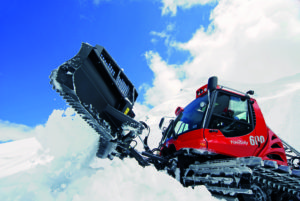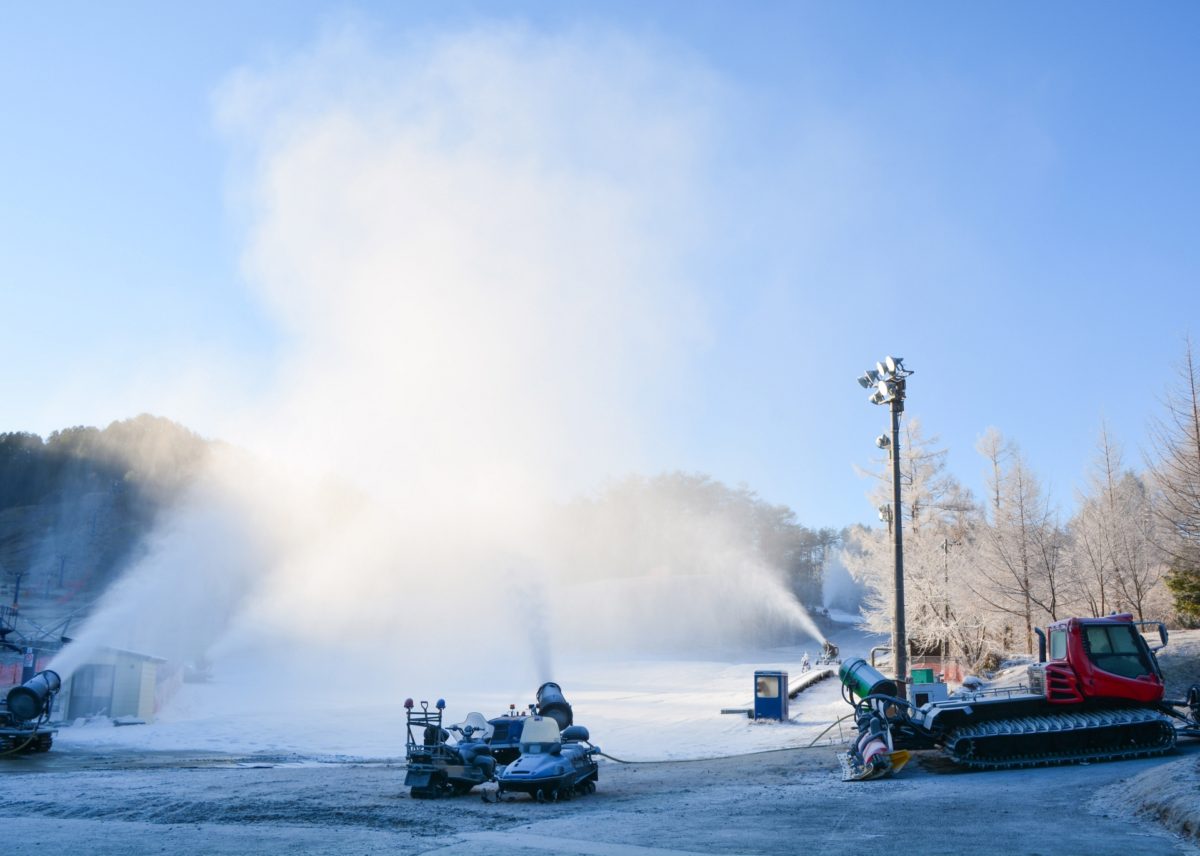This series explains various aspects of Japan's ski resorts from various perspectives in order to get to know them in more detail. The third is about snow machines and snow machines that support the early start of the season and follow up on the problem of lack of snow. Ski resorts, which are known for their early start of the season, have started to operate at full capacity in preparation for opening at the end of October or early November. What exactly is this snow machine & snow machine?

Although it was put into practical use in the United States, the origin of artificial snow was in Japan!?
Humans have a long history of artificially making snow. The first recorded event was in Japan in 1936 (Showa 11), before World War II. At the time, physicist Ukichiro Nakaya, who was a professor at the Faculty of Science at Hokkaido Imperial University (now Hokkaido University), was immersed in snow research. He succeeded in producing the world's first artificial snow in the university's low-temperature laboratory. We are clarifying the process of crystal formation and the relationship between snow and weather conditions.
Dr. Nakatani left behind great achievements as an authority on low-temperature science, and was later involved in the production of science films on the themes of snow and ice, as well as taking on the challenge of researching Greenland's ice caps (giant masses of ice). However, Mr. Nakatani's artificial snow was not primarily intended for commercialization. In other words, it is not directly connected to the artificial snow that is spread on the slopes today.
Artificial snow was put into practical use for the first time in the late 1940s. At a ski resort in the United States, it is said that artificial snow made from crushed ice was used. After that, a snow-making machine was invented by modifying a painting spray gun, and a snow-making machine called 'Ice Schlinger' that crushed ice was born. The latter was also introduced at the indoor slope Sayama Ski Resort, which opened in 1959 in Saitama Prefecture.
It was in the 1960s that artificial snow machines of almost the same type as today became popular. The first outdoor ski resort in Japan to use this system was Karuizawa (currently Karuizawa Prince Hotel Ski Resort) in 1961. Artificial snow machines became popular in Japan in the late 1970s. The background is that ski resorts have opened one after another in various places.
And during the bubble period from the end of the 80's to the beginning of the 90's, there were slopes and people would gather if there was a lift. As a result, ski resorts were built in areas with low temperatures but constant snowfall. As a result, the number of snow blowers increased rapidly.
After the end of the ski boom, the need increased for a different reason. Due to global warming, ski resorts that used to rely on natural snow have had to rely on artificial snow. On the other hand, the main purpose of snow machines was to ensure the opening days of ski resorts and to keep the amount of snow until the temperature dropped below freezing.
In particular, it will come in handy for ski resorts aiming to open a little earlier. Notable examples include Snow Town Yeti, which opened early, Karuizawa Prince Hotel Ski Resort, and ski resorts in the Okumino area of Gifu Prefecture.
Kashiyama Kogyo is a pioneer in the development of snow machines and snow machines in Japan, and released the first machine made in Japan in 1978.

``Snow Makers'' and ``Snow Cannons'' for Making Artificial Snow - What Is the Principle of Making Snow?
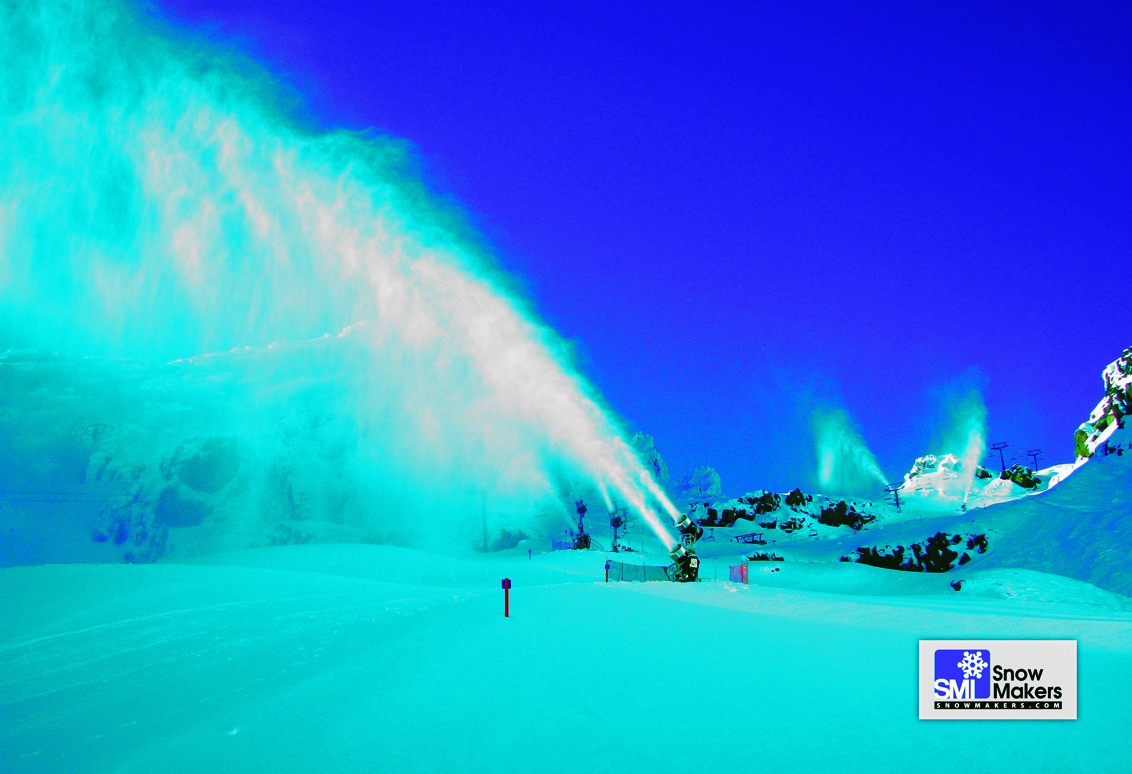
Machines that produce artificial snow
●Artificial snow
●Artificial snow machines
Did you know that there are two main types of
Snow blowers are further classified into these two categories. A. “Fan type (snow machine)” that spreads by rotating a fan
B. “Gun type (snow gun)” that sprays from the tip of a long and narrow pipe
Both types of snow machines use the same principle to make snow fall. Water is supplied from the base area, and it is granulated and dispersed into the air. This tiny water bubble is called the nucleus. The "nucleus" turns into ice (snow) as it falls through the air.
However, even if you spray water on a ski resort at -1°C, it will not turn into snow before it hits the ground. Then why does the water sprinkled by the snow machine turn into snow?
By compressing the air and releasing it at the same time as the "nucleus", the snow machine uses the adiabatic expansion effect to instantly create an extremely low temperature space.
The key here is "adiabatic expansion", a phenomenon in which the temperature rises when water or air is compressed, and the temperature drops when it expands. The air that has been compressed and the temperature has risen is released vigorously, expanding all at once = becoming colder. Now, let's take a look at the features of each of the two types of snow machines, the "fan type" and the "gun type."
"Fan-type" snow machine that creates a large amount of snow at low temperatures

The fan type is equipped with a compressor (a machine for compressing). A large fan is attached, but this is to increase the flight time of the injected "nucleus". By lengthening the flight time, the ice (snow) crystals grow larger before landing.
The amount of air used is small, and running costs are modest. It also has the advantage of making large amounts of snow easily at low temperatures. Conversely, in principle, it is said that when the temperature is high (minus 1 to 3 degrees Celsius), it cannot make much snow fall.
[Snow machine] Fan type (snow machine)
・A large amount of snow can fall at low temperatures
There are two main types: electric and hydraulic types
・The new model does not lose power even at high temperatures
▼
"Gun-type" snow machine that evolved and overcame its weaknesses
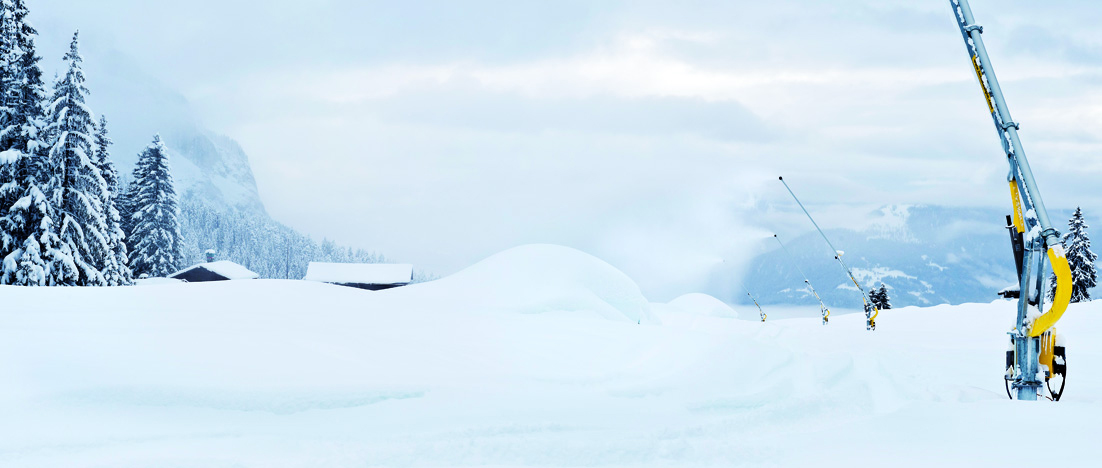
On the other hand, the conventional gun type supplies compressed air through piping from the base area in the same way as water, and creates snow by the adiabatic expansion effect and the effect of increasing the flight time of the "nucleus". Since it uses a large amount of air, it also has the disadvantage of large energy consumption. On the other hand, it is said to be excellent for snowfall at high temperatures.
However, recently, unlike the conventional gun type, something called "low air gun" or "stick type" with reduced air consumption has appeared. It is a type that uses the adiabatic expansion effect of the compressor to form the "core", but does not use the air pressure to increase the flight time. The flight time is earned by "dropping from a high place". In principle, the air consumption is low, so running costs can be greatly reduced. In Europe and the United States, it seems that most of them have switched to this type.
What they all have in common is that snow machines can't produce the amount of snow that ski resorts need until the temperature drops below -1°C. Of course, the colder the weather, the more snow it will form. Automated systems have also been developed that detect the temperature, automatically start snowfall when the temperature reaches the set temperature, and increase the amount of water when the temperature drops.
[Snow machine] Gun type (snow gun)
・Exhibits strength even at high temperatures
Consumes a lot
of energy ・Recently shifts to energy-saving models
"Snow making machine" whose principle is completely different from "snow making machine"

Snow machines, on the other hand, produce ice in a plant located in the base area. Then, it is a system that pulverizes it into a shape that is as close as possible to snow and spreads it on the slope. Often called an "ice crusher". This is the same as making shaved ice in the summer, and it does not depend on the temperature until it makes snow (breaks the ice). Just as shaved ice does not melt for a certain amount of time even at room temperature, the snow that is made keeps its appearance for a while even if the temperature is not below freezing.
Snow machines can make snow at any time, so they are essential for securing a start for the opening of the ski resort, and are useful for obtaining a stable amount of snow at the beginning of the season.
This is because it is very unlikely that a snow machine would suddenly sprinkle snow on an area where there is no snow and the temperature does not fall below zero. Ski resorts that open with artificial snow usually look like this photo (bottom) before they open. The plant makes ice and crushes it into snow. In order to reduce the area exposed to sunlight and rain, first store it in a mountain shape. Before the opening of the business, it is spread out with a snow compactor and spread over the course.
Although it costs much more than a snow machine, the overwhelming strength of a snow machine is that it can make snow even when the temperature is not below freezing.

[Snow machine]-Machine
that makes snow-like ice from the beginning-
snow regardless of the temperature
-Cost is higher than a snow machine
What are the manufacturers that make snow machines and snow machines?
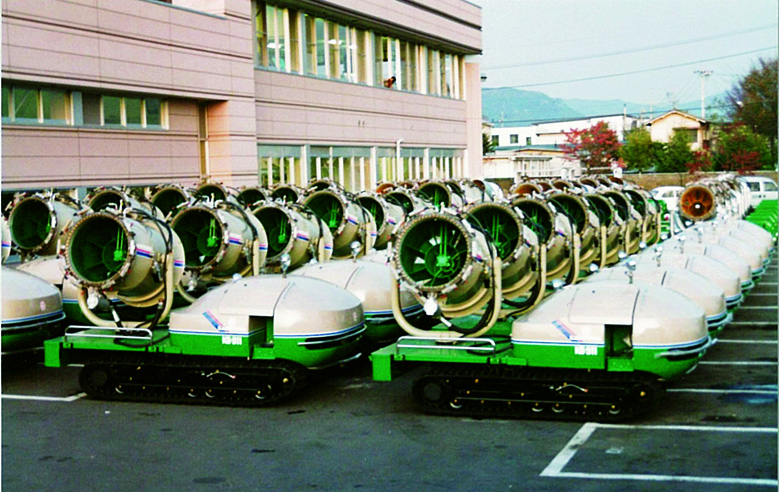
There are major manufacturers in Europe and the United States for snow machines and snow machines. SMI, which was founded in 1965, is representative of the United States, and has delivered more than 12,000 machines so far, 90% of which are said to be in active use. Techno Alpin from Italy boasts the top market share among European manufacturers. Founded in 1990, it has grown rapidly to become a global manufacturer in a short period of time. The company that sells these two brands in Japan is Snow Systems, which also handles snow groomers and snowmobiles.
On the other hand, Japan is also continuing its own development. In 1978, Kashiyama Kogyo in Nagano Prefecture became the first domestic manufacturer to manufacture domestically-produced snow-making machines and snow-canning machines, and since then has held the largest market share among domestic manufacturers.
A total of 3,000 units have been delivered since 1979. It also has a track record of supporting the Nagano Olympics. By the way, snow town Yeti, which is the first to open in Japan, and Karuizawa Prince Hotel Ski Resort, which is the second to open, have installed Kashiyama's snow machines.
The KB-911 is the most powerful model in Kashiyama Industry's line-up of snow machines with an unprecedented style. Self-propelled by a diesel engine, no external power supply is required. With only water supply, you can make snow immediately in the place where you want to make snow. In addition, it is equipped with a powerful engine and snow crawlers that can climb slopes of up to 30 degrees. It is surprising that it can run while snowing.
the third category
The indoor ski slopes are basically the home ground for frozen snow made by soaking water in the "superabsorbent polymer" used for absorbent materials such as paper diapers and sanitary napkins. The original existence is "Skiing Inn Tsudanuma" which was operated in the 90's. At present, "Snova" in various places uses artificial snow belonging to this system.

*Continues to Part 2 (Part 2 will be released on 10/27)
Interview cooperation and photo provided by: Kashiyama Kogyo Co., Ltd. , Snow Systems Co. (in Japanese syllabary order)
Text: Edited by Mizorogi Daisuke
/ STEEP editorial department
Source: Re-edited from 2017 BRAVOSKI vol.2
[Writer Profile] Daisuke Mizorogi
Has been involved in skiing for over 20 years as a member of the BRAVOSKI editorial staff.
He has been covering moguls since the 1990s and has extensive experience in the field of ski resort guides. On the other hand, he has created many unconventional projects that are not found in existing ski magazines, combining subculture and skiing. Currently, while bearing the title of "Showa culture researcher", he writes and edits in various genres other than skiing. He stands in the most indoor position in the outdoor world and the most outdoor position in the indoor world. https://www.d-mizorogi.com/
* The "Road to Ski Resort Mania" series that you want to read together
